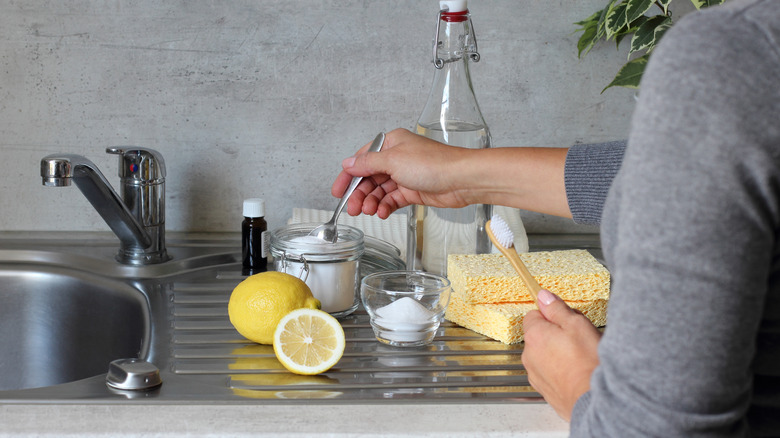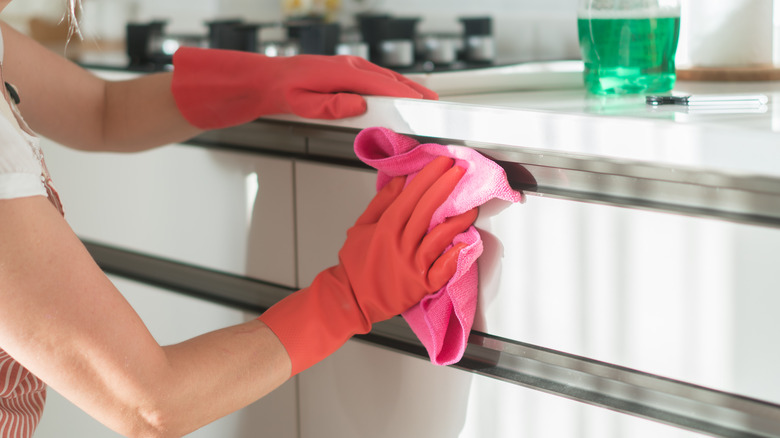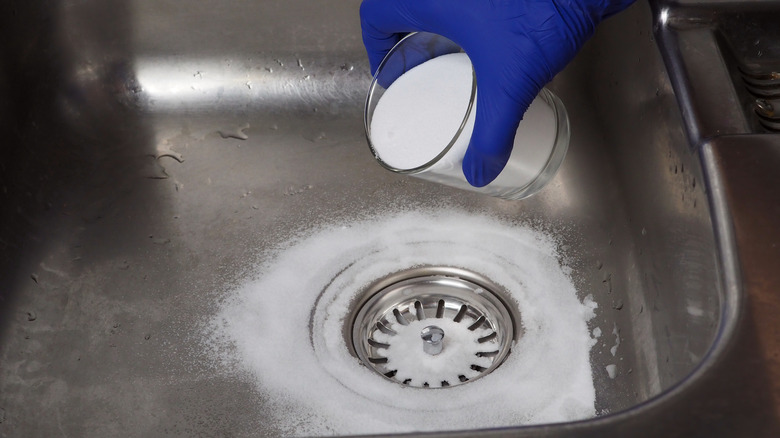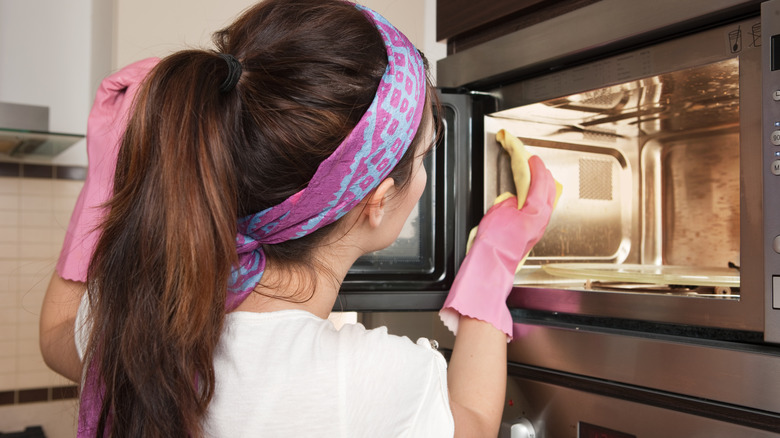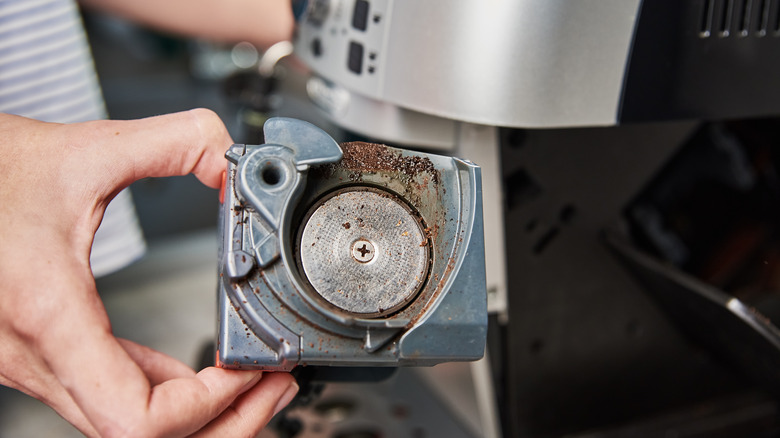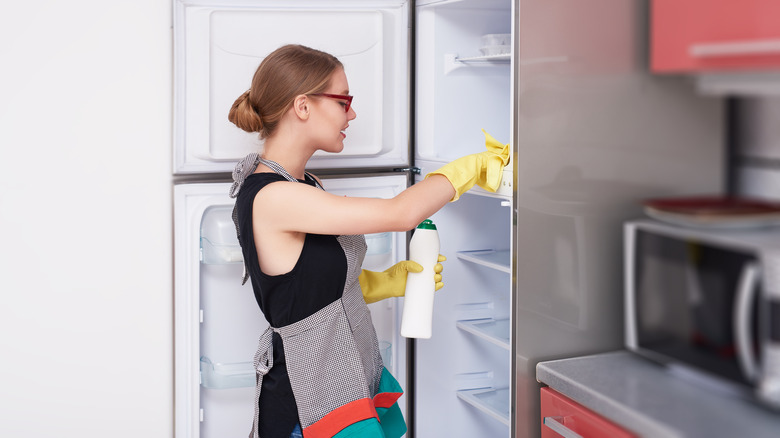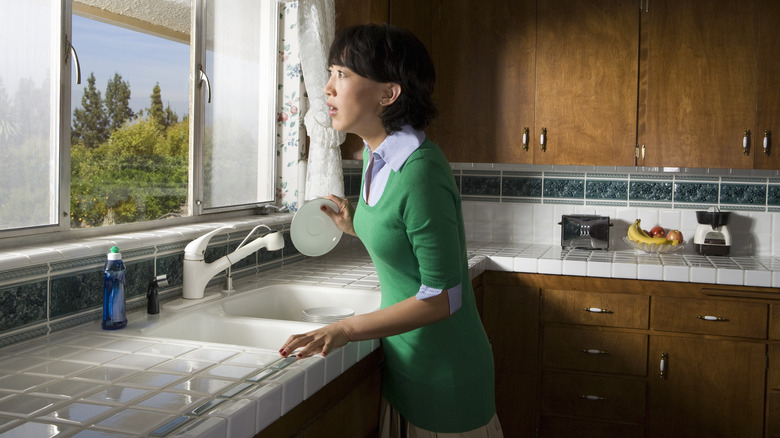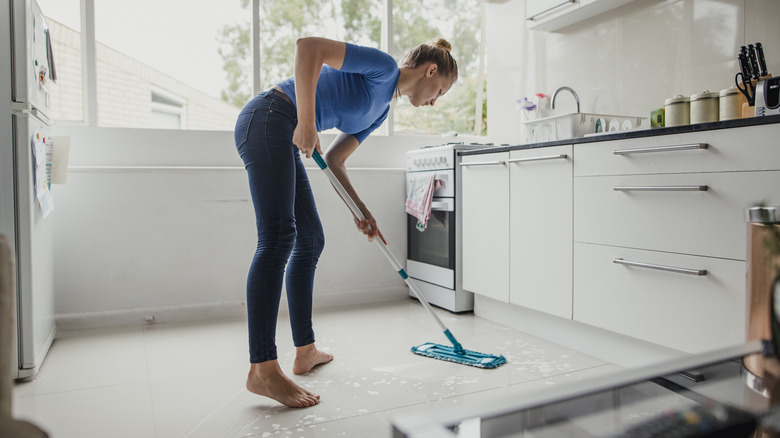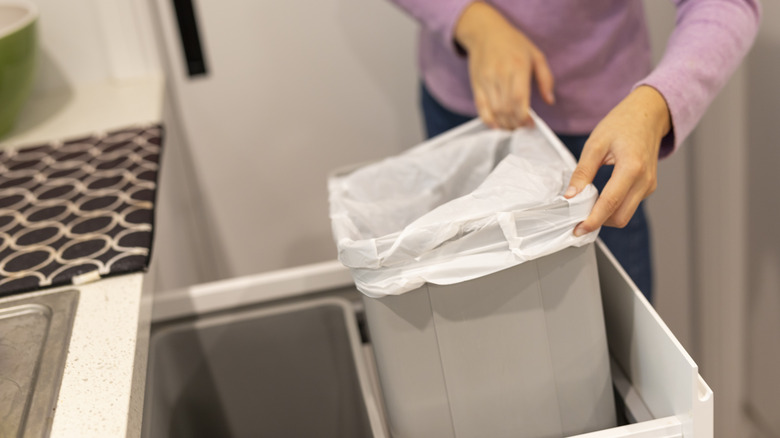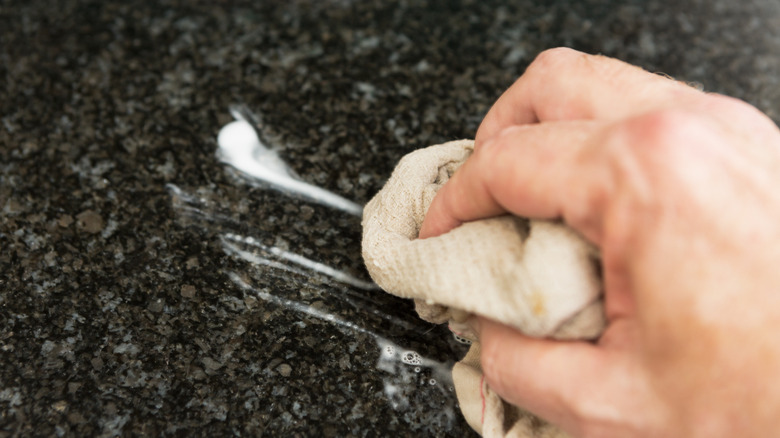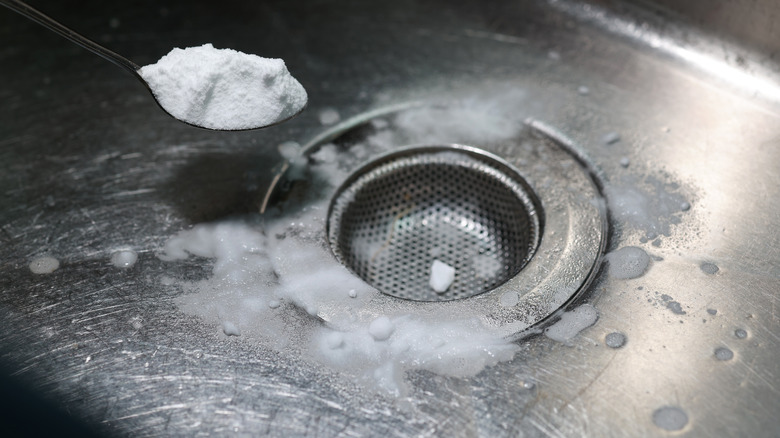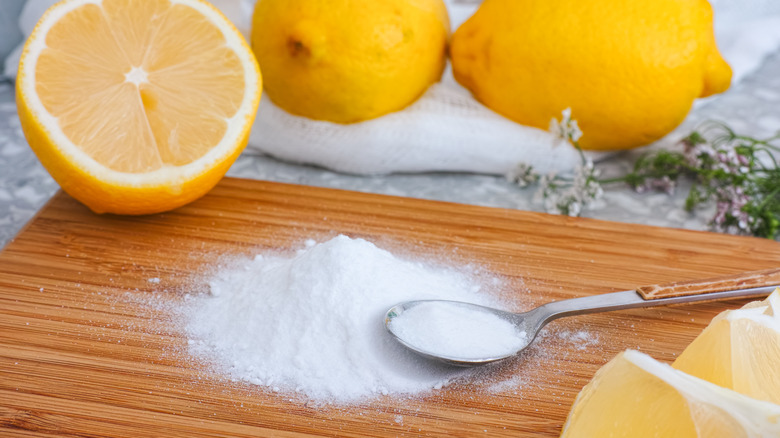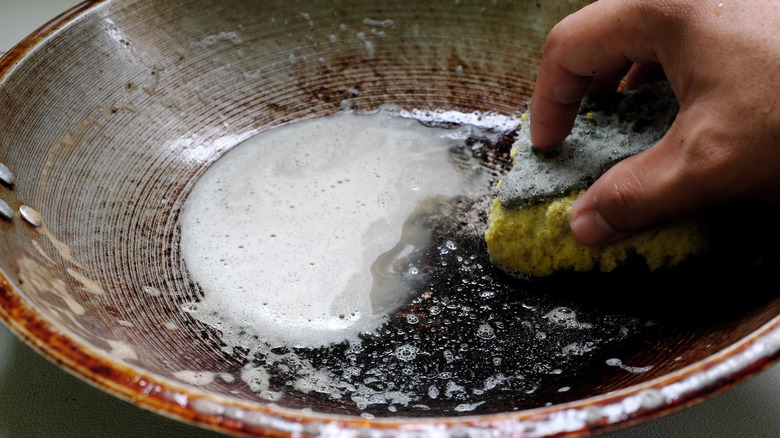Clever Ways To Use Baking Soda For A Cleaner Kitchen
Your kitchen cleaning routine often requires a bit of trial-and-error to help you figure out what works and what doesn't to take on stinky smells or greasy countertops and cabinets. Baking soda is touted as a great alternative cleaner. However, you also know that there are a lot of claims about what it can and can't do floating around.
Understanding the science behind why baking soda works better for some cleaning tasks than others will save you time and stop you from potentially damaging appliances or surfaces. Along with cleaning your surfaces, using baking soda helps leverage its properties to enhance your cleaning routine without the drawbacks that can come with using chemical-based cleaners.
This allows you to skip common issues like scrubbing too hard with abrasive materials or using strong chemical cleaners that could strip or damage kitchen finishes and materials. Embracing this more eco-friendly cleaning routine ensures you get a clean kitchen that is warm and inviting.
Clean under the kitchen cabinets with lemon and baking soda
As a slightly gritty substance, baking soda (sodium bicarbonate) is great for clearing up and removing odors. Mixing it with acidic things like lemon juice causes a chemical reaction that fizzes and helps get rid of smells and breaks down dirt so it's easier to rinse off. Since lingering odors are common in the kitchen, this makes it extremely useful. Baking soda's natural makeup ensures it's safe to use around food prep areas, and it gives you a gentle but strong solution to help you clean all the small corners or areas of your kitchen with ease.
For a scrub-free hack to clean under your kitchen cabinets, mix a cup of water with ¼ to ½ cup of baking soda and lemon juice to get a thick paste consistency. Pour enough on a microfiber cloth to dampen it, wring out the excess, and wipe it under your cabinets. Leave it alone for five to 10 minutes (or more for extra dirty surfaces), then get a soft sponge damp and wipe the residue away. The baking soda neutralizes any odors, and the lemon juice can leave a fresh, citrus-laced scent while the acid cuts through grease and grime.
Deodorize and clear kitchen drains with baking soda and vinegar
Combining baking soda and vinegar gives you a natural and safe way to clear and deodorize your kitchen drains. Baking soda naturally gets rid of smells and has a slightly rough form that reduces smells. Acetic acid in vinegar makes a quick bubbly reaction when it mixes with baking soda, which gives off carbon dioxide. Even though it's fast, it can help loosen residue and gunk in your kitchen drains, like food particles or organic particles. It's non-toxic to ensure you get a clean drain without harsh chemicals.
To deodorize and clear your kitchen drains, Mr. Rooter Plumbing says to switch the hot water on and let it run to pre-rinse the drain. Turn it off and carefully pour a cup of baking soda down the kitchen drain, followed by two cups of heated vinegar. They'll fizz and bubble for a few seconds when they come into contact and leave it alone for roughly an hour before running the hot water again to flush the pipes. Ideally, you'll use this as part of your regular maintenance routine to periodically refresh the drain or areas you can't reach with a scrub brush so layers of gunk don't have time to build up, leading to bigger problems. Remember that this method only works right away when it's bubbling. If you wait, they'll cancel each other and not work well.
Use baking soda paste to clean the microwave of stubborn residue
Baking soda's texture helps get it off without causing damage and neutralizes any lingering odors after you finish cooking. If you have a habit of heating things without a cover, food tends to splatter around. The microwave's heat makes it harden and stick, and it's difficult to remove without scratching the finish.
To use baking soda to scrub at burnt residue in the microwave, pour a cup of water and two tablespoons of baking soda in a microwave-safe cup or bowl and heat it for three minutes on high. The steam will start to loosen the dirt as it gets hotter. After the microwave stops, leave it there for a few minutes to keep the steam working. Take the bowl out and clean the inside of the microwave. Make a thick paste with baking soda and water and layer it over the spots if they don't come off by wiping. Give it some time to work before you wipe it off. To finish, dry the microwave's interior with a towel or leave the door open and let it air dry to get a fresh-smelling, clean appliance. Ideally, you'll repeat this process monthly to keep your microwave food-safe and ready to go.
Remove built-up coffee stains and smells from the coffee maker
Baking soda can strip off built-up coffee stains and odors because it features natural deodorizing and cleaning properties. A coffee maker can get dirty and smelly over time because of the oils and residues that build up. This can change the taste of your coffee. Baking soda naturally gets rid of smells and scratches without using chemicals.
To use a baking soda hack to get your coffee maker spotless, start by removing the pot and pouring boiling water into it until you fill it to the top. Mix in two tablespoons of baking soda. Set it aside and give the mixture at least 30 minutes or more to work before rinsing it with warm water. To clean the reservoir, fill it to the top with hot water and stir in roughly ½ cup of baking soda. Switch on a regular cycle and let this mixture go through the coffee maker before emptying it. Run two or three additional water cycles to eliminate any residue. If you spot exterior stains, mix water and baking soda to get a thick paste and scrub until they lift. Wipe away the residue with a soft, damp cloth, and re-clean it every two to four months.
Clean the refrigerator's interior with baking soda and warm water
Even though baking soda is a fine powder, it's abrasive enough to scrub away stains or sticky and greasy residue without scratching or dulling surfaces. It also absorbs odors instead of masking them, making it a solid ally to help clean your refrigerator because this space can collect food odors. It's chemical-free and safe to use around your food items, and it won't leave residue or fragrances like commercial-grade cleaners when you use it.
You want to unplug your refrigerator before you clean it and then pull any food items so you don't have to move them as you clean. Carefully remove any shelving units or crisper drawers to clean the inside. Get a soft cloth and a bucket of soapy, warm water and do a pass of the whole interior. For the second round, mix two tablespoons of baking soda into a quart of warm water and scrub any leftover spills, spots, or residues, ensuring you get into the corners and cracks. For extra-stubborn spots, mix baking soda with water to create a paste and leave it to sit until you're ready to rinse everything. Wipe everything off and return a third time with a clean, damp cloth to finish cleaning before putting your shelves, drawers, and food back and plugging it back in.
Use a baking soda paste to remove stains from plastic food storage containers
If you put the wrong things into your plastic food storage containers, it will stain them. Also, it'll probably smell or taste like whatever you put it in, especially curries or pasta sauce. Luckily, baking soda readily cleans and whitens, making it a wonderful solution to help you get rid of stubborn stains. You can apply baking soda as a scrubbing agent without being concerned about the plastic getting damaged because it's a moderately alkaline powder. So, you get to reuse your containers, confident that they look and smell fresh.
Mix water and baking soda to get a thicker paste to scrub any stained areas on your plastic food containers to remove the icky smells and discoloration. Apply this paste to the stained areas after the first scrub, then let it sit overnight. Come back and rinse the container with warm water. If you don't see any stains or lingering odors, dry and store it. However, if stains are still visible, you may have to repeat this process several times and leave it in the sun for a few hours to finish neutralizing odors.
Scrub the kitchen floor with baking soda-infused water
Sprinkling baking soda into your mop water and going over your kitchen floors is a great way to clean because it's a slightly abrasive mixture and deodorizer that strips grime from the flooring. Spilling things as you cook or track dirt and grime in is common, leading to a buildup of dirt and filth on the floor. When you dissolve baking soda in water, you get an effective but gentle cleaner that will help remove these things without damaging the floor. The abrasive properties gently scrub and the alkalinity helps cut through greasy messes. Baking soda will also take care of odors without leaving any residues that your kids or pets could get into.
Apply a coating of baking soda to a moist sponge and apply it as a pre-wash treatment to any oily or stuck-on dirt. As it breaks up the spots combine ½ cup of baking soda in a pail of warm water, then use it to clean the floor. Get a clean mop and water and rinse the floor to remove any lingering baking soda-infused water. The mop should be damp instead of soaked to avoid waterlogging the floor and creating fall hazards. Let the floor air dry or wipe it clean with a dry mop head to finish. If you have wax-treated floors in your kitchen, like hardwood, don't use this recipe because it can damage the finish.
Deodorize your trash cans with a sprinkle of baking soda
Food scraps and other waste materials that decompose inside a trash can in the kitchen offer a perfect setting for foul odors to build up. Instead of masking these odors, baking soda neutralizes them. Also, baking soda's slight moisture absorption qualities may lower the risk of bacterial growth, leading to fewer odors. This method removes unpleasant smells that may remain in the kitchen and is safe for use around children and animals.
After removing the waste, clean the trash can thoroughly, including the area surrounding the lip and lid. Before wiping the can with a sponge or microfiber cloth, sprinkle baking soda into the bottom of the can and allow it to sit undisturbed for up to ten minutes. Scrub the outside of the can, then dry and rinse it and put a clean garbage bag back inside. To prevent corrosion in a metal can, place baking soda inside a coffee filter and tie it before adding the baking soda to the bottom.
Remove grease stains from granite countertops with a baking soda paste
Baking soda works well to strip grease from your granite countertops because it's mildly abrasive and it's also naturally absorbent. Grease can quickly build up throughout your kitchen, and getting it off surfaces can be challenging without leaving a shiny residue. Also, it's more challenging to clean because some traditional cleaners are too strong for granite and can damage it. Baking soda's fine particles get into the grease, break it down, and lift it from porous countertops. It protects the granite's integrity and how it looks while ensuring you get a clean surface.
To remove grease from granite countertops, fill a small bucket with warm water and pour enough baking soda to make a thick paste. Get a spatula or use your hand to carefully spread the baking soda mix over the stain and cover it with a layer of plastic wrap. Weigh down or tape the edges to get a seal around the edges and leave it for 24 hours. Peel away the plastic wrap, gently scrape the hardened paste off, and rinse with warm water before drying with a soft towel to prevent water spots from forming. If you still see the grease stain, repeat the process.
Shine your stainless steel kitchen sink with a sprinkle of baking soda
Cleaning with baking soda is a safe and effective trick to get a nice shine on your stainless steel sinks, and it's eco-friendly. Stainless steel looks dull and lifeless as it gets coated in fingerprints, water spots, grime, and general buildup. Unlike harsher chemicals, baking soda's mild abrasive makeup lets it gently scrub at these spots without scratching the surface. When mixed with water, you get a thick paste that slowly scrubs the grime to reveal the shiny finish. Also, using it in a stainless steel sink can cut through food smells from leftover food particles or scraps. Since it's non-toxic, it's safe to use around your kitchen.
To get a shiny, clean stainless steel sink with baking soda, get the surface damp and wipe it down with a soft cloth and some dish soap to strip the surface grime. Rinse any soap residue and sprinkle a layer of baking soda, ensuring it sticks to the surfaces. Get a soft sponge or cloth and gently scrub the baking soda into the stainless steel, working in the grain's direction for the best results. Since baking soda is mildly abrasive, take care not to press too hard and accidentally create micro scratches. When the grime or stains lift, rinse with hot water and dry it with a soft cloth to get rid of any lingering residue and stop water spots from forming.
Deodorize and disinfect your cutting boards with baking soda and lemon
Baking soda and lemon are effective for disinfecting and deodorizing your cutting boards. Your cutting boards are a prime spot for bacteria and odors to hang around because they get exposed to a host of food items and are used frequently. Baking soda neutralizes odors and breaks down grease, making it great for cleaning oily or smelly residues. When you pair it with lemon with citric acid content, you get antibacterial properties to clean and disinfect by killing germs hiding in the grooves or cut marks. Both ingredients are natural and safe, making them great to use on any surface that comes into contact with food items.
To use this baking soda cleaning hack, sprinkle a generous layer of baking soda onto your cutting board's surface. Cut a lemon and half and use it like you would a sponge, rubbing it into the baking soda. The scrubbing action will push the baking soda into the cutting board's surface to help eliminate bacteria and odors. Leave it for around 10 minutes to give the lemon's antibacterial properties time to work before scrubbing the board again with the second lemon half. Finish by rinsing it with hot water to get rid of any residue, wipe it down, and leave it to dry.
Remove stubborn, baked-on food from pots and pans
It's easy to accidentally burn things onto your pots and pans when you cook, especially if you tend to cook at higher temperatures. Doing so will leave a hard film on your pots and pans, and dish soap won't be enough to pull it off without hard scrubbing. However, since baking soda is only mildly abrasive, you can scrub your cookware with it without worrying about damaging the finish. It works well on glass, ceramic, and stainless steel when you use it as a thick paste with a little water, making it a useful cleaning ally.
One of the best ways to clean pans with baking soda is by making a paste with a cup of water and baking soda and spreading it in a thick layer over your burned-on gunk. You want a scrubbing consistency, so you may have to adjust your ratios if it doesn't work well. Once it's on, leave it alone for 15 to 20 minutes so it has time to start breaking down the film to make scrubbing easier. If it doesn't come off, empty it, coat the bottom with a layer of baking soda and ½ cup of vinegar and set it to boil for 10 minutes before you scrub it. Rinse everything with lukewarm water to finish and dry your cookware so water spots don't form.
